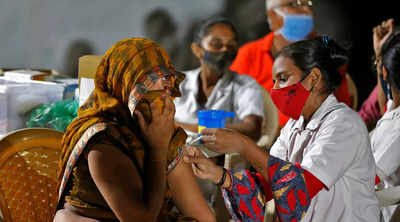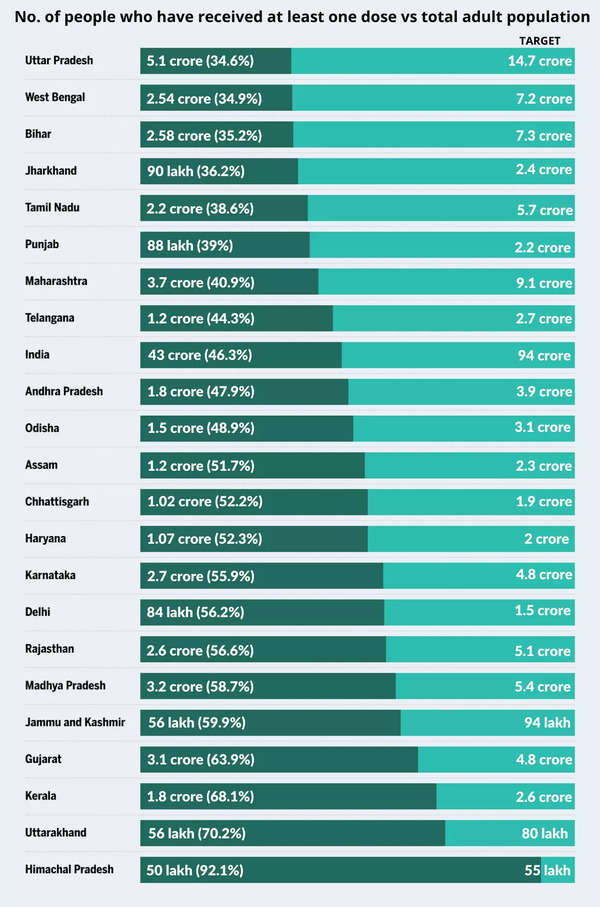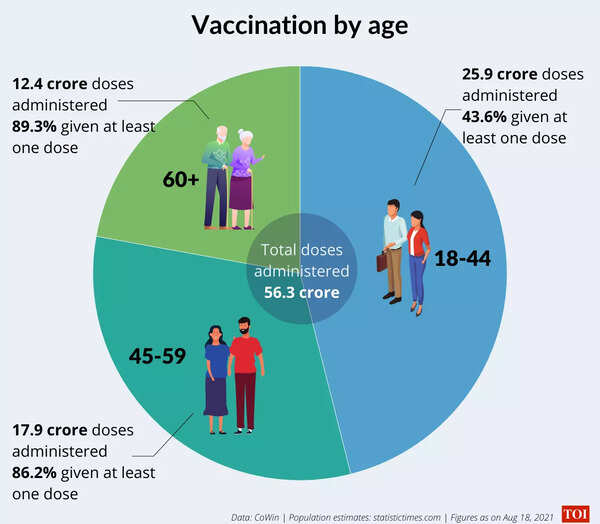- News
- India News
- In 5 charts: Good and bad of India's Covid vaccination drive
Trending
This story is from August 19, 2021
In 5 charts: Good and bad of India's Covid vaccination drive

NEW DELHI: India's nationwide vaccination drive completed eight months this week. Considering the enormity and complexity of the nation's demography, the gains made in this period have been decent. Nearly half of all eligible adults have received at least one dose of the vaccine, which includes over 90% of the elderly population (people aged 60 & above).
However, if the potency of new Covid variants and experience of the devastating second wave have taught us anything, India must ramp up vaccinations to achieve Covid herd immunity as quickly as possible.Besides, India's vaccination coverage is still quite low when compared to western countries like US and UK.
Here are the main takeaways from India's vaccination programme so far ...
State-wise coverage
 (Population data: Twitter | Prof Shamika Ravi)
(Population data: Twitter | Prof Shamika Ravi)
The vaccination coverage across states vis-a-vis the size of population has been uneven so far.
States like Uttar Pradesh, Bihar and West Bengal — all with sizeable adult population — have administered at least one dose to just one-third of people.
Worst-hit Maharashtra is not far ahead with just over 40% of adults receiving at least one dose.
On the brighter side, Kerala, Gujarat and Madhya Pradesh have all made decent progress in vaccinations. Delhi, too, has covered over 56% of its people with at least one dose.
Hill states like Uttarakhand and Himachal Pradesh, where population size and density are low, have administered at least one dose to 70% and 90% of the people respectively.
Where do vulnerable states stand
Among the sates most affected by the pandemic, Kerala and Delhi have made good progress when it comes to vaccination coverage. Karnataka, which is the third-worst-hit state in India, has also managed to cover a sizeable chunk of its population.
On the other hand, Maharashtra, Tamil Nadu and Andhra Pradesh lag far behind when it comes to vaccination coverage.
UP, Bengal and Bihar, where per million cases are not that high, have not done too well on the vaccination front either.
Meanwhile, moderately-hit states like Gujarat, MP, Assam and Rajasthan have maintained a healthy pace of vaccinations.
Notably, Kerala — which has been reporting maximum new cases and is the second worst-hit overall — has done pretty well on vaccination.
Over 68% of the state's population has now received at least one dose of the vaccine.
Protecting the elderly

India started administering vaccines to all those aged 60 or above starting February 1 in the second phase of the inoculation drive.
Based on latest population estimates, it has covered over 90% of its elderly population with at least one dose.
Similarly, among those in the 45-59 age bracket, over 86% have been given at least one dose.
In the 18-44 age group, who were the latest to become eligible starting May 1, nearly 44% have received at least one dose of the vaccine so far.
But are we vaccinating fast enough?
The overall pace of vaccination is picking up slowly but not fast enough to cover roughly 94 crore adults by the end of this year.
In the last two weeks, India has administered over 55 lakh doses on average every day. At this rate, it will only be able to cover 70% of the adult population, way short of the government's target of universal coverage by the end of this year
Moreover, when it comes to procurement of doses, the government is yet to order the requisite vaccines needed to cover all adults.
In response to a question in Rajya Sabha, the health ministry had last month said that over 100 crore doses of Covishield (64.1 crore) and Covaxin (36.5 crore) have been ordered so far. The latest order of around 66 crore doses came as recently as July 16.
India roughly needs around 188 crore doses to cover its adult population of 94 crore. Considering factors like vaccine wastage, this figure would shoot up to over 200 crore doses.
So besides increasing the pace of vaccinations, the Centre also needs to ensure procurement in the coming weeks to fuel a healthy rate of inoculation.
However, if the potency of new Covid variants and experience of the devastating second wave have taught us anything, India must ramp up vaccinations to achieve Covid herd immunity as quickly as possible.Besides, India's vaccination coverage is still quite low when compared to western countries like US and UK.
Here are the main takeaways from India's vaccination programme so far ...
State-wise coverage

The vaccination coverage across states vis-a-vis the size of population has been uneven so far.
States like Uttar Pradesh, Bihar and West Bengal — all with sizeable adult population — have administered at least one dose to just one-third of people.
Worst-hit Maharashtra is not far ahead with just over 40% of adults receiving at least one dose.
On the brighter side, Kerala, Gujarat and Madhya Pradesh have all made decent progress in vaccinations. Delhi, too, has covered over 56% of its people with at least one dose.
Hill states like Uttarakhand and Himachal Pradesh, where population size and density are low, have administered at least one dose to 70% and 90% of the people respectively.
Where do vulnerable states stand
Among the sates most affected by the pandemic, Kerala and Delhi have made good progress when it comes to vaccination coverage. Karnataka, which is the third-worst-hit state in India, has also managed to cover a sizeable chunk of its population.
On the other hand, Maharashtra, Tamil Nadu and Andhra Pradesh lag far behind when it comes to vaccination coverage.
UP, Bengal and Bihar, where per million cases are not that high, have not done too well on the vaccination front either.
Meanwhile, moderately-hit states like Gujarat, MP, Assam and Rajasthan have maintained a healthy pace of vaccinations.
Notably, Kerala — which has been reporting maximum new cases and is the second worst-hit overall — has done pretty well on vaccination.
Over 68% of the state's population has now received at least one dose of the vaccine.
Protecting the elderly

India started administering vaccines to all those aged 60 or above starting February 1 in the second phase of the inoculation drive.
Based on latest population estimates, it has covered over 90% of its elderly population with at least one dose.
Similarly, among those in the 45-59 age bracket, over 86% have been given at least one dose.
In the 18-44 age group, who were the latest to become eligible starting May 1, nearly 44% have received at least one dose of the vaccine so far.
But are we vaccinating fast enough?
The overall pace of vaccination is picking up slowly but not fast enough to cover roughly 94 crore adults by the end of this year.
In the last two weeks, India has administered over 55 lakh doses on average every day. At this rate, it will only be able to cover 70% of the adult population, way short of the government's target of universal coverage by the end of this year
Moreover, when it comes to procurement of doses, the government is yet to order the requisite vaccines needed to cover all adults.
In response to a question in Rajya Sabha, the health ministry had last month said that over 100 crore doses of Covishield (64.1 crore) and Covaxin (36.5 crore) have been ordered so far. The latest order of around 66 crore doses came as recently as July 16.
India roughly needs around 188 crore doses to cover its adult population of 94 crore. Considering factors like vaccine wastage, this figure would shoot up to over 200 crore doses.
So besides increasing the pace of vaccinations, the Centre also needs to ensure procurement in the coming weeks to fuel a healthy rate of inoculation.
End of Article
FOLLOW US ON SOCIAL MEDIA










